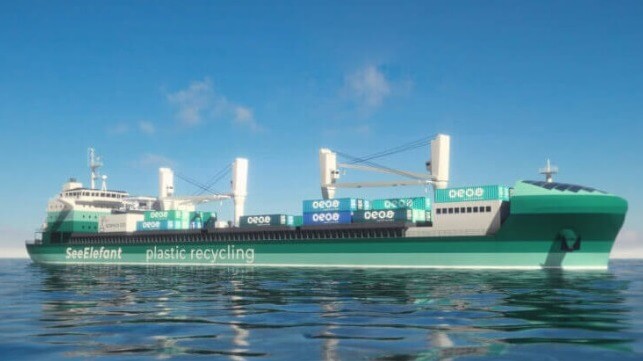Non-Profit Plans to Convert Bulker into Plastics Recycling Center

A German non-profit environmental group is developing a plan to convert an existing bulker into a floating environmental center as part of their system to capture and recycle ocean and on shore plastics. According to the group in addition to the mobile nature of the vessel, it also provides a turnkey solution that requires no additional space in targeted metropolitan areas and has financial advantages.
One Earth – One Ocean reports that it finalized the initial design for the vessel concept named SeeElefant 2023 in February of this year with a team of specialists in plant engineering and shipbuilding. They are currently working to develop the necessary network for investment, financing, ship management, and operation while at the same time closely monitoring the secondhand ship market for a suitable vessel. The goal is to commission the conversion before the end of 2023, start trial operations in the North Sea or Baltic in mid-2025, and place the vessel in Southeast Asia in 2026.
“With SeeElefant, we are finally able to combine the latest technologies from the shipbuilding and waste management sectors with certifiable lowest emission values, turnkey and useable worldwide,” said Harald Frank, the project development lead. “Our SeeElefant will make an important contribution to combating and disposing of plastic waste.”

The bulker would house recycling facilities as well as a research facility
The target vessel is a dry bulk carrier approximately 590 feet in length with four cranes on deck. This would provide enough space to create a recycling plant with a capacity of 60,000 tons per year. The ship would contain a facility that would sort, shred, and process marine garbage. The plastic waste would be pressed into bales for processing. Waste other than recyclable plastic would be used to feed a waste-to-energy plant also aboard the vessel with the power sold and fed into shore power grids. In addition, they plan to host a large research facility to conduct further plastic and waste analysis as well as to conduct tests such as waste-to-fuel technology.
The vessel would be positioned at a shore-based transfer station that would be responsible for handling the baled plastic waste for recycling. It would also make it possible for the vessel to receive and process waste from shore. As soon as industrial plastics-to-fuel plants are available, they also plan to convert plastic back to sulfur-free oil on board.

Smaller crafts would collect the plastic which would be processed on the converted bulker
The SeeElefant would work in conjunction with the group’s specially designed garbage collection ships known as SeeHamster and SeeKuh. The SeeHamster is their smallest unit in use for over a decade. It has evolved into catamarans with a length of about 15 feet that have a collection capacity of up to 500 kg. SeeKuh is a bigger design, either a boat or skid dragged by boats, to collect a larger amount of trash in coastal waters.
One Earth – One Ocean is currently operating projects to remove plastic waste from the waters in Cambodia, Brazil, Indonesia, the Philippines, and Egypt, and plans to launch a SeeHamster on Lake Victoria in Uganda this year. The association is also involved in the research on microplastics as well as education, awareness-raising, and documentation on the subject of marine litter.
The addition of the SeeElefant is the next phase in their process. Organizers believe it will play a critical part in expanding their mission to eliminate waste from the oceans.
